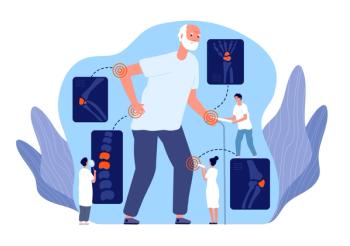
Introduction to Systemic Lupus Erythematous and Lupus Nephritis
Rheumatologist Ellen Ginzler, MD, MPH, and nephrologist German Hernandez, MD, FASN, FACP, provide an overview of systemic lupus erythematosus and lupus nephritis.
Episodes in this series

Ellen Ginzler, MD, MPH: SLE, or systemic lupus [erythematosus], is an autoimmune multisystem disease. It primarily affects women of childbearing age, but it can be seen as a new diagnosis in children, adolescents, and even older adults. As a multisystem disease, it involves many organs in the body, but the most common are the joints, with swelling, pain, and tenderness, and skin manifestations, like the typical butterfly rash. There’s photosensitivity, so sunlight can cause a flare of disease. In addition to the skin and joint manifestations, it can affect the heart and lungs. The internal organ most commonly affected is the kidneys. That’s what we call lupus nephritis.
Often in the beginning, a patient may develop lupus nephritis very early in their course, or it may occur after several years of other manifestations. It may be asymptomatic in the beginning and picked up only through laboratory tests, such as finding protein or red blood cells in the urine, or sometimes the beginning of renal insufficiency, where the kidneys don’t clear wastes as normally as they should.
German Hernandez, MD, FASN, FACP: Lupus is an autoimmune disease that affects close to 300,000 Americans. For the most part, it affects young women. It can also affect men. About 90% of the cases are women, and 10% are men. Lupus is basically an autoimmune disease in which your own immune system starts to cause inflammation and damage to pretty much any organ system in your body. The difference between lupus—which can be limited to the skin, joints, or other organs—and lupus nephritis is that the kidney is involved in lupus nephritis. The kidney is suffering from an autoimmune attack and undergoing a lot of inflammatory damage. About 40% to 50% of patients with lupus will get some form of lupus nephritis, and it’s those who have lupus nephritis who have the highest morbidity and mortality. It’s the involvement of the kidneys in patients with lupus that drives the severity of the disease in general.
Patients with lupus can present in many ways: with a rash, joint aches, ulcers in their mouth, and so on. A lot of times, making a diagnosis can take quite a bit of time because it’s hard to pinpoint. When patients develop lupus nephritis, for the most part, they will have abnormalities in their urine, whether this is the spillage of protein into the urine because of inflammatory damage of the kidney or the presence of red blood cells in the urine, which shouldn’t be there. Usually this is a urine test. It’s done in the doctor’s office. It’s not necessarily blood that the patient can see. Once a patient is thought to have lupus nephritis, the test to confirm it and stage the level of damage they have would be a kidney biopsy. That also determines the type of treatment that goes with it.
Transcript edited for clarity.
Newsletter
Stay ahead of policy, cost, and value—subscribe to AJMC for expert insights at the intersection of clinical care and health economics.







